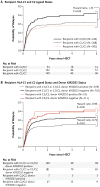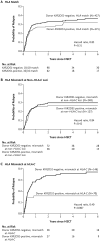HLA-C-dependent prevention of leukemia relapse by donor activating KIR2DS1
- PMID: 22931314
- PMCID: PMC3767478
- DOI: 10.1056/NEJMoa1200503
HLA-C-dependent prevention of leukemia relapse by donor activating KIR2DS1
Abstract
Background: Of the cancers treated with allogeneic hematopoietic stem-cell transplantation (HSCT), acute myeloid leukemia (AML) is most sensitive to natural killer (NK)-cell reactivity. The activating killer-cell immunoglobulin-like receptor (KIR) 2DS1 has ligand specificity for HLA-C2 antigens and activates NK cells in an HLA-dependent manner. Donor-derived NK reactivity controlled by KIR2DS1 and HLA could have beneficial effects in patients with AML who undergo allogeneic HSCT.
Methods: We assessed clinical data, HLA genotyping results, and donor cell lines or genomic DNA for 1277 patients with AML who had received hematopoietic stem-cell transplants from unrelated donors matched for HLA-A, B, C, DR, and DQ or with a single mismatch. We performed donor KIR genotyping and evaluated the clinical effect of donor KIR genotype and donor and recipient HLA genotypes.
Results: Patients with AML who received allografts from donors who were positive for KIR2DS1 had a lower rate of relapse than those with allografts from donors who were negative for KIR2DS1 (26.5% vs. 32.5%; hazard ratio, 0.76; 95% confidence interval [CI], 0.61 to 0.96; P=0.02). Of allografts from donors with KIR2DS1, those from donors who were homozygous or heterozygous for HLA-C1 antigens could mediate this antileukemic effect, whereas those from donors who were homozygous for HLA-C2 did not provide any advantage (24.9% with homozygosity or heterozygosity for HLA-C1 vs. 37.3% with homozygosity for HLA-C2; hazard ratio, 0.46; 95% CI, 0.28 to 0.75; P=0.002). Recipients of KIR2DS1-positive allografts mismatched for a single HLA-C locus had a lower relapse rate than recipients of KIR2DS1-negative allografts with a mismatch at the same locus (17.1% vs. 35.6%; hazard ratio, 0.40; 95% CI, 0.20 to 0.78; P=0.007). KIR3DS1, in positive genetic linkage disequilibrium with KIR2DS1, had no effect on leukemia relapse but was associated with decreased mortality (60.1%, vs. 66.9% without KIR3DS1; hazard ratio, 0.83; 95% CI, 0.71 to 0.96; P=0.01).
Conclusions: Activating KIR genes from donors were associated with distinct outcomes of allogeneic HSCT for AML. Donor KIR2DS1 appeared to provide protection against relapse in an HLA-C-dependent manner, and donor KIR3DS1 was associated with reduced mortality. (Funded by the National Institutes of Health and others.).
Figures



Comment in
-
Control of acute myeloid leukemia relapse--dance between KIRs and HLA.N Engl J Med. 2012 Aug 30;367(9):866-8. doi: 10.1056/NEJMe1205900. N Engl J Med. 2012. PMID: 22931322 No abstract available.
-
Prevention of leukemia relapse by donor activating KIR2DS1.N Engl J Med. 2012 Nov 22;367(21):2054-5; author reply 2055. doi: 10.1056/NEJMc1211673. N Engl J Med. 2012. PMID: 23171112 No abstract available.
-
Donor activating KIR2DS1 in leukemia.N Engl J Med. 2014 Nov 20;371(21):2042. doi: 10.1056/NEJMc1411443. N Engl J Med. 2014. PMID: 25409391 No abstract available.
References
-
- Ruggeri L, Capanni M, Casucci M, et al. Role of natural killer cell alloreactivity in HLA-mismatched hematopoietic stem cell transplantation. Blood. 1999;94:333–9. - PubMed
-
- Ruggeri L, Capanni M, Urbani E, et al. Effectiveness of donor natural killer cell alloreactivity in mismatched hematopoietic transplants. Science. 2002;295:2097–100. - PubMed
-
- Lanier LL. NK cell recognition. Annu Rev Immunol. 2005;23:225–74. - PubMed
-
- Giebel S, Locatelli F, Lamparelli T, et al. Survival advantage with KIR ligand incompatibility in hematopoietic stem cell transplantation from unrelated donors. Blood. 2003;102:814–9. - PubMed
Publication types
MeSH terms
Substances
Grants and funding
LinkOut - more resources
Full Text Sources
Other Literature Sources
Medical
Research Materials
Miscellaneous
